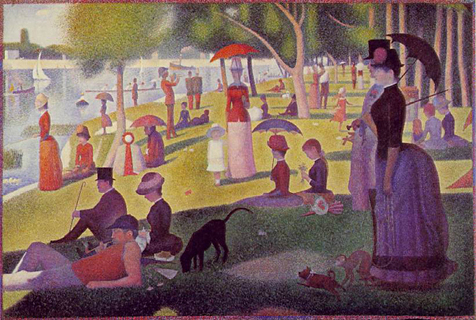The third of this month’s four pictures for summer is A Sunday on La Grande Jatte, by the French Post-Impressionist painter Georges Seurat. Painted between 1884 and 1886, this large and imposing canvas shows a group of Parisians enjoying a sunny Sunday afternoon out in the park. The work hangs in the Art Institute of Chicago.
To match his modern subject matter, Seurat painted in what he himself declared to be a self-consciously modern style, rendering this snapshot of Parisian suburban park-life in a dense chromatic patchwork of little dabs or dashes of paint. This “pointillist” technique was derived by the artist from the colour theories advanced by the leading optical scientists of his time, particularly that of Michel-Jeune Chevreul, who had argued that the essence of visual experience consisted of a mass of rays of spectral light. But Seurat applied the technique with anything but scientific rigour, creating a work which, in the end, is more striking for its overall harmony of forms and colours than for its presumed optical accuracy. The result is a vision of the world that seems at once abstracted from reality, and eternally becalmed.
The “Grande Jatte” was an elongated island in the
Seurat painted the northwestern shore...


